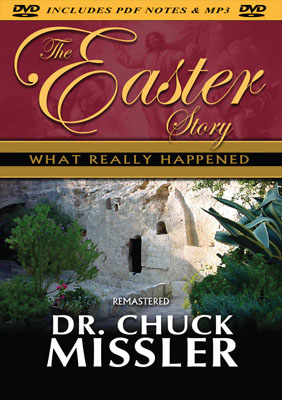This month we celebrate Easter. Whoops! Why do we label our most holy holiday with its pagan obfuscation? It is at this time that we celebrate the very Gospel itself: "...how that Christ died for our sins according to the Scriptures; that He was buried; and that He rose again the third day according to the Scriptures."1 Yet we still tend to label this most distinctive of celebrations with its reference to the pagan Queen of Heaven: Ishtar to the Babylonians, Astarte to the Semites, Aphrodite to the Greeks, and Ashtoreth in Hebrew, the mother of Tammuz, etc. And why do we still talk about rabbits who lay eggs? This, too, is an allusion to the Golden Egg of Astarte, a vestige of the pagan fertility cults of an ancient darkness.
We should join our Jewish friends and refer to this as Passover with its associated festivities: the Feast of Unleavened Bread and the Feast of First Fruits.2 The month of Nisan - re-designated "the beginning of months"3 - includes the first three feasts (of the Mosaic Seven) that anticipate the "First Coming" of the Messiah. [It is the 7th month, Tishri, which includes the final three feasts that anticipate the Second Coming. Between these two seasons we find the Feast of Shavout (the Feast of Pentecost), which highlights the intervening ecclesia, the Church.]
John the Baptist, when he first introduces Jesus publicly, twice highlights His prophetic role: "Behold the Lamb of God which taketh away the sin of the world."4 That's a very Jewish title.
The Strange Remedy
During the wilderness wanderings, on one of the many occasions that the children of Israel were murmuring against God's provision, God sent deadly serpents as a judgment. In response to Moses' prayer for the people, God instructed Moses to set up a bronze serpent on a pole, and everyone who looked upon it would live.5
A strange remedy. Why did God employ this peculiar method to provide for their healing and restoration? Prophecy is (strategic) pattern, not simply (tactical) predictions. It would be Jesus Himself who would explain this strange remedy during that evening visit of Nicodemus:
And as Moses lifted up the serpent in the wilderness, even so must the Son of man be lifted up: That whosoever believeth in him should not perish, but have eternal life.
John 3:14-15
In fact, this would occasion the most well-known verse in the Bible:
For God so loved the world, that he gave his only begotten Son, that whosoever believeth in him should not perish, but have everlasting life.
John 3:16
There are many graphic allusions to the Messiah in the Old Testament, and each one is singularly instructive.6 There were two occasions that Jesus was "the rock" that provided the living water.7 The first time Moses was instructed to smite the rock and it provided the needed water. 8 The second time Moses didn't follow directions, and as a result he was denied entrance into the Promised Land! 9 (If he had followed his instructions, these two occasions would have profiled the two comings of the Messiah!)
This emblem - a brass serpent raised on a pole - is distinctive in that the Lord Jesus Christ personally applied it to Himself. The more you examine it, the stranger it appears: brass was the Levitical symbol of judgment; brass was the metal that was associated with fire (as the brazen altar, etc.). The serpent was symbolic of sin, introduced in the Garden of Eden. This is a strange emblem, indeed, for the Savior of mankind:
For he hath made him to be sin for us, who knew no sin; that we might be made the righteousness of God in him.
2 Corinthians 5:21
And this is precisely what we celebrate during the Passover Season: His being raised up in our stead. Unfathomable. We may spend an eternity attempting to embrace the implications of this precious truth, and what it cost Him to purchase our eligibility to be in His presence. [Our two Briefing Packs, The Agony of Love, and From Here to Eternity, attempt to probe some of the implications that we celebrate this season. These have been included with other seasonal favorites on a single audio package.]
A Symbol of Healing
This incident during Israel's wilderness wanderings led to the Greek legends of Aescalapius, the god of healing, who was symbolized as a brass serpent on a pole, or cross. (It is amusing to notice that many medical professionals have adopted the caduceus, which includes two serpents entwined on a staff. What makes this amusing is that this was actually the symbol for Hermes, the god of commerce!)
An Instructive Denoument
The lessons from this strange brass serpent continued. Centuries later, King Hezekiah became disturbed when he discovered that this very artifact was still around and was being worshiped! So he had it destroyed, calling it Nehustan ("that brass thing").10
There is a sober warning here. Our Briefing Pack, Digging Up the Truth, is a review of Biblical archaeology. The remarkable fruits of dedicated, disciplined investigators and scholars have enriched us all; the tangible discoveries of archaeology can bring the abstract and distant into the palpable reality of our present. However, there is a dark side. Artifacts can also become a nehustan (a brass thing) if we allow a self-imposed myopia to limit our perspective and awareness to what we can "handle." (How many "experts" in the dust of the past are personally spiritually blind? Are the more prominent "Biblical Archaeology" publications fountains of faith or shackles of pseudo-scholastic skepticism?)
Let's be cautious about any artifact or "proof," whether it is the Shroud of Turin, purported splinters of wood from Noah's Ark, or whatever. The more it seems authentic, the more dangerous it can become. It can become a fetish that can shackle and restrict our spiritual growth. It, too, can become Nehustan. Let's remember Thomas's insistence for tangible proof:
But he said unto them, Except I shall see in his hands the print of the nails, and put my finger into the print of the nails, and thrust my hand into his side, I will not believe.
And after eight days again his disciples were within, and Thomas with them: then came Jesus, the doors being shut, and stood in the midst, and said, Peace be unto you.
Then saith he to Thomas, Reach hither thy finger, and behold my hands; and reach hither thy hand, and thrust it into my side: and be not faithless, but believing.
And Thomas answered and said unto him, My Lord and my God.
Jesus saith unto him, Thomas, because thou hast seen me, thou hast believed: blessed are they that have not seen, and yet have believed.
John 20:25-29
I believe that this, too, was a fulfillment of prophecy:
And one shall say unto him, What are these wounds in thine hands? Then he shall answer, Those with which I was wounded in the house of my friends.
Zechariah 13:6
It wasn't the nails that wounded Him: it was Thomas's unbelief. Let us, too, pray with tears, "Lord, help our unbelief."11
This Passover Season, let's use the opportunity to seriously commit ourselves to embracing the most awesome and precious gift we can ever receive; a gift that has come to us at a price we cannot comprehend; a gift that establishes our eligibility throughout eternity. Baruch HaShem!
Notes:
- 1 Corinthians 15:1-4.
- See our Briefing Pack, The Feasts of Israel, for a review of the prophetic as well as commemorative implications.
- Exodus 12:2.
- John 1:29, 36.
- Numbers 21:4-9.
- Genesis 22; Hebrews 11:19; Hosea 11:1; Matthew 2:15. Each one is distinctive and instructive in method as well as content.
- 1 Corinthians 10:4.
- Exodus 17:6-7.
- Numbers 20:8-13.
- 2 Kings 18:4.
- Mark 9:24.





